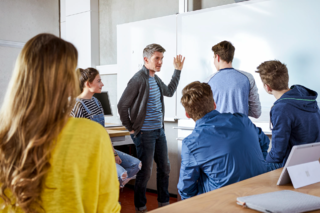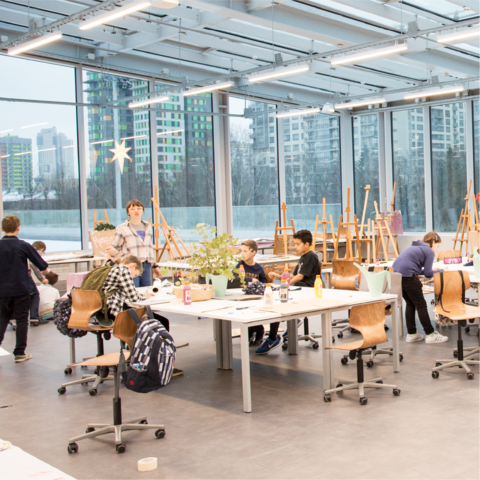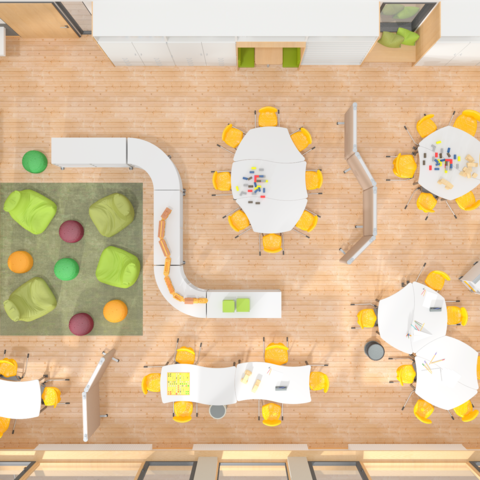12.01.2024
Mastering complexity creatively and collaboratively
DESIGNING EXPERIENCE SPACES FOR FUTURE SKILLS
In order for learners to become creators in changing times, they need skills such as creativity, collaboration and critical thinking in addition to specialised knowledge. The education sector is therefore seeing a shift from the acquisition of knowledge to the acquisition of skills. This calls for new spaces in which these skills can be strengthened - but what do they look like?
From acquiring knowledge to acquiring skills
It has always been a challenge to understand our world, especially today. Due to developments such as globalisation, climate change and automation, more and more is in motion and everything seems to be connected to everything else. This is also reflected in the education plan: How can the dimensions of globalisation be characterised politically, socially, economically and ecologically? And what influence do humans with fossil fuels have on the carbon cycle? In order to understand these complexities, make informed decisions and act in a crisis-proof manner, the generation of the future will need not only knowledge and values, but also an equally complex mix of special skills - the so-called "Future Skills" (also: 21st century skills). What future skills are there and what do they achieve?
Mastering complexity with Future Skills
Creative ingenuity, prototypical and collaborative work and the use of analogue and digital media are particularly valuable skills for developing innovative and sustainable solutions. Skills such as respectful communication, empathy and a sense of responsibility are what really inspire people from different backgrounds to live and work together. And a mindful way of living and learning slowly but surely leads to a loving attitude towards oneself and the world.
In order to promote the full range of these future skills in the classroom active forms of learning such as self-determined, research-based and cooperative learning are required - for example, heated debates, upcycling clothes during cross-class sustainability weeks or even meditation.
So how is a space designed that enables active learning experiences?
Designing versatile experience spaces for future skills
Unimagined powers lie dormant in the learning space that can specifically support learners in acquiring skills. The following design ideas show how these can be unleashed for the future skills of creativity, communication, collaboration and mindfulness.
Creativity
The Future Skill creativity means thinking in new ways and creating something original. This is particularly successful when experimenting, working or combining opposites. And yes, even when making mistakes and being bored. A space that supports this learning is full of inspiring impulses that stimulate associative thinking and encourage people to make things. While red and orange tones, dimmed lighting and round shapes stimulate the creative spirit of development, a wide variety of analogue and digital media help creativity to flourish. Valuable are therefore robust work tables where work can be done and mature ideas can be made tangible with models. Makerspaces, laboratories and workshops are prime examples of such creative experience spaces.

Communication
Being able to communicate on both a professional and personal level is another skill that makes it easier to live together. These necessary meeting places enable comfortable seating landscapes that invite you to sit in different positions, and footrest chairs that bring learners together at eye level.
On raised open spaces with blackboards or digital screens, learners can gain confidence in presenting and arguing and the seated audience can practise active listening and asking questions.
And to practise remote communication, teamwork between electrified learning furniture and digital end devices is just as helpful.
COLLABORATION
For shared learning experiences, a quick and uncomplicated change between different group sizes and forms of learning is essential. Depending on the type of collaboration - whether a lively exchange, mutual help or a hot brainstorming session - mobile and compact school tables in particular are driving this spatial transformation forward. Individual workstations are restructured into group areas or entire areas are cleared to create space for seating circles. Workstations where learners have a choice of different ways to express themselves, such as whiteboards or pinboards, support communication. And to make collaborative learning a reality outside the classroom, furniture is used that skilfully distributes groups across the available learning environments - including in the corridor and outside the learning centre.
Mindfulness
Creativity can flourish and collaboration can take place harmoniously when mind and body are lovingly nurtured. This is why mindfulness is also an important part of Future Skills. Rooms full of warmth and cosiness help you to feel at ease, focus on your own needs and gently let go of stress.
For example, ergonomic and flexible school chairs, height-adjustable tables or upholstery elements at various heights are available for students to fulfil their inner urge to move. And in the shelter of shielded retreat islands and cosy study areas, you can pause for a moment and take a deep breath.
Calm also returns when the various learning impulses always have a specific place. It also allows learners to practise mindful handling of their learning materials naturally. For this helpful structure and organisation, sufficient shelves and storage space a blessing.

Many of the possibilities for designing an active experience space are therefore already inherent in the functions of the educational furniture - whether it's chairs that bring you up to eye level or whiteboards that allow you to develop ideas. This means that interior design plays a key role in promoting future skills; and educational furniture becomes a loyal companion for learners in changing times.

 Deutsch
Deutsch
 English
English
 Français
Français






